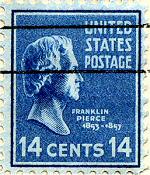
 |
What To Avoid In U.S. Philately
By John M. Hotchner
 This seems like an odd title, and an odd subject, but it is one that every collector considers — largely without conscious thought. For every decision we make about what to collect, there is an implied decision about what not to collect. What I'd like to do with this column is to put some of the considerations that go into those decisions on the table with the hope that we all might pay a little more attention to — and maybe question — the assumptions that lurk behind those decisions.
This seems like an odd title, and an odd subject, but it is one that every collector considers — largely without conscious thought. For every decision we make about what to collect, there is an implied decision about what not to collect. What I'd like to do with this column is to put some of the considerations that go into those decisions on the table with the hope that we all might pay a little more attention to — and maybe question — the assumptions that lurk behind those decisions.First, let me say that I am not questioning the decisions. As I have said many times, one of the glories of our hobby is that we each get to make of it what we wish. My only concern is that our decisions be truly informed ones. So, where to begin? Perhaps it is with the basic question of United States Mint vs. Used, and the underlying feeling with Mint that "It's the money, stupid!"
Collecting U.S. mint stamps was a popular collecting style when I was getting into collecting in the (can it be!) 1950s, but there is an urban myth now that this is too expensive. No doubt that buying many of the first 550 U.S. stamps in mint condition will set one back a chunk of change. But we also need to keep in mind that the way to best appreciate the art of stamps is to gaze upon them when they are uncluttered by a cancellation. And that there are 3,500 regular postage issues beyond the first 550, most of which cost pennies rather than dollars.
Furthermore, these are the stamps most likely to be appreciated as art anyway. The first 550 are often gaudy, repetitious, and mostly monocolor. As a devotee of that era, I can say that they have their charm, but I have chosen to collect them with the lightest possible cancel I can find to avoid the expense of mint, but that does not mean that I should not collect mint from 1920 to a date. And who knows, I could hit the lottery one day.
An adjunct to the Mint-Used problem is the matter of never-hinged. The philatelic pundits tell you that Hinged Is Bad." I beg to differ. If you are investing and are looking to get back the biggest return on your investment, then, yes, never-hinged is better. But as a collector, you will pay a price for that view. It is that you will have a lot fewer stamps in your collection because never-hinged commands a significant premium for the first 1000 U.S. stamps.
My sense is that most of us do keep a weather eye on the value of our stamps, and there is no doubt that value is enhanced by never-hinged. But as a collector, not an investor, I am honestly more concerned about filling the blanks in my album. And since I have made the basic decision to display my stamps design-side facing out, I choose to be concerned with how that looks, not so much with the gum side. Of course, I will pick a lightly-hinged specimen over a heavy-hinged example (all other things being equal).
Avoiding whole eras of U.S. stamps seems to be a trend these days. The American Philatelic Society new applicants list is full of people who report their collecting preference as "U.S. from (or to) 1940," "U.S. 20th Century," and such.
Why restrict to a particular era? There are lots of good reasons: affordability, focus on one's own history, a preference for a particular challenge or type of art, etc., etc.
But I am more concerned here with why we chop out an era than with what we do collect. There seem to be three areas to look at. The first is the expense of collecting early stamps. That is true if you must have mint, especially mint-never-hinged (see above). But a good representative collection of early U.S. used is possible without having to put the family on a prolonged diet of bread and water. Well over half of the pre-1900 U.S. stamps will be under $10 per stamp. And remember that stamp collecting is a marathon, not a sprint. Buy one stamp every two weeks if that is what you can afford. At the end of 20 years you will have put together a very nice collection. Bottom line: Completeness may not be possible, but that is not the only way to define the challenge.
 The second area is the sometimes-heard statement, "I don't like these modern issues — they just don't make stamps the way they used to." I went through a collecting period like that, but came to realize that it was a case of "one loves what one knows." I grew up with the Presidential series and the Liberty series. They will always be my favorites. But the more I worked with and looked at later stamps, the more they grew on me. And that is the secret, I think. Get to know and appreciate the modern stamps for what they are, rather than being focused on what they aren't, and you will get to love them too.
The second area is the sometimes-heard statement, "I don't like these modern issues — they just don't make stamps the way they used to." I went through a collecting period like that, but came to realize that it was a case of "one loves what one knows." I grew up with the Presidential series and the Liberty series. They will always be my favorites. But the more I worked with and looked at later stamps, the more they grew on me. And that is the secret, I think. Get to know and appreciate the modern stamps for what they are, rather than being focused on what they aren't, and you will get to love them too.Finally, there is the oft-heard complaint about some U.S. issues: "They're too complicated. I just can't figure them out." I'm sympathetic, but not convinced. The mountain always seems unimaginably high when you stand at the bottom and think about climbing it. And that is true of issues like the watermarked vs. non-watermarked issues of 1895-1902, or the Washington-Franklins, with their watermarks, perforations, paper, rotary vs. flat plates, etc. And the modern era with the multitudinous varieties of die cuts should not be forgotten.
But I would submit that it is of such minutia that fascination is born. Begin to learn about the possible varieties, and a new world opens. Part of that world can be that you learn what is truly scarce and how to identify it. And suddenly, you have the ability to comb through a dealer's stock and say quietly to yourself, "Eureka!" There among the $l-or-less stamps is a rarity, or what I call a "Uniquity," that you can add for a song. These can be catalogued varieties, or simply a rare precancel, a newly discovered double transfer, an unusual cancellation, or something else that appeals to you. There is very little that equals the thrill of "philatelic prospecting" like this. It does require an investment of time to learn the basics, but as hard as it may look, you can master them.
 A first cousin of the collector who chops out whole eras is the collector who avoids "the Back of the Book:" all those categories released for special purposes such as Air Mail, Postage Due, Specimens, Christmas Seals, Revenue use, etc. The underlying feeling may be that there is enough challenge in the regular postage material, or the additional expense may be a deterrent, or the simple lack of familiarity with the material may play a part. (One does not love what one does not know!) But I would offer that precisely because these are not as heavily collected as the regular postage category, they are an especially fun playground; especially when it comes to areas that are not so popular; where truly scarce stamps can be had for affordable prices simply because there is not a heavy demand for them.
A first cousin of the collector who chops out whole eras is the collector who avoids "the Back of the Book:" all those categories released for special purposes such as Air Mail, Postage Due, Specimens, Christmas Seals, Revenue use, etc. The underlying feeling may be that there is enough challenge in the regular postage material, or the additional expense may be a deterrent, or the simple lack of familiarity with the material may play a part. (One does not love what one does not know!) But I would offer that precisely because these are not as heavily collected as the regular postage category, they are an especially fun playground; especially when it comes to areas that are not so popular; where truly scarce stamps can be had for affordable prices simply because there is not a heavy demand for them.I'm not suggesting that you "double your pleasure-double your fun" by taking on the entire Back-of-the-Book. Rather, my thought is that one should not reject those categories out of hand. Let yourself play with the idea that one or more categories of BOB material might just add a little spice to your collecting.
Again, I am not suggesting that any decisions you have made in the past are "wrong;" only that we all make decisions that are based on what we know — or think we know — to be true. And as a paraphrase of Josh Billings notes, "It ain't the things we don't know that get us in trouble, it's the things we know that just aren't so." Hopefully this column will have shed a little more light on some aspects of U.S. stamp collecting, and the result will be more informed decisions.
Should you wish to comment on this column, or have questions or ideas you would like to have explored in a future column, please write to John Hotchner, VSC Contributor, P.O. Box 1125, Falls Church, VA 22041-0125, or email, putting "VSC" in the subject line, at jmhstamp@verizon.net